
|
Revelations from Crete |
|
| |
Crone Magazine Article - Circles within Circles
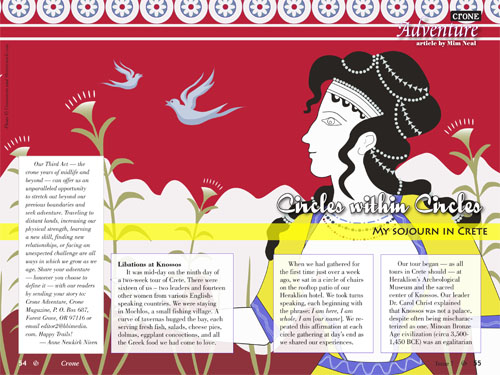
**********************************************************************************************************************************
Why has it been so long since I've posted anything on my blog? Lots of reasons.
First, I was a long way away – more than six thousand miles away – in Crete.
Second, I have had a long illness – upper respiratory problems that have festered since mid-September. It's November!
Third, in Crete I was immersed in an ancient culture – the Minoan – that flourished on Crete from about 3,000 BCE to about 1,450 BCE when it was wiped out by a combination of a tsunami and invading Mycenaeans.
The Minoan culture was matrifocal: it honored women – mothers, maidens, and crones. It was peaceful: it had no kings, no armies, no weapons of combat. It was communal and egalitarian: no very rich or very poor. It was creative: the remnants of its art that have survived for nearly 3,500 years are stunningly beautiful. Frescoes and caves echo with the songs that serenaded goddesses that represented the earth, the sea, the sky, birth, trees, the harvest – all the manifestations of life (and death as a component of the cycle).
Perhaps, like most of us, I had thought such a culture was some utopian fantasy – something that could not possibly exist. But it did exist – for almost two thousand years.
The goddess pilgrimage in Crete (www.goddessariadne.org) was led by spiritual scholar and author Dr. Carol Christ and her assistant, Mika Scott. There were 14 of us on the tour to sites that had been sacred to the Minoans (or in some way revealed a feminine focus). We were from far-flung places: 3 Australians, 3 Canadians, 1 Alaskan, 3 from the Midwest, 1 from Massachusetts, 2 from Colorado, and 1 ex-pat from England who had lived on Crete for six years.
For two weeks we visited sites in caves, in archeological ruins, at mountain springs, in Byzantine churches, or convents, or cliff-tops. At each site, we performed a ritual or in some way acknowledged its significance to our ancestors and to ourselves.
We began to believe that a peaceful, creative, egalitarian culture once existed and, possibly, could exist again.
So I guess I have been stunned to silence. Letting the truth of this sift down into my being. I still have respiratory problems. But I'm home. And I think, finally, I am ready to tell some of the stories of some of what I learned. Stay tuned. , |
| |
The Lost Empire of Atlantis by Gavin Menzies was one of a half dozen books I read prior to visiting Crete. In it, Menzies makes a fascinating case for his theory that Crete was Atlantis and the Minoans (original residents of Crete) were global traders going as far as Lake Superior in North America in their quest for the components of the bronze that characterized their times.
I still don't know if I believe it (you can check out aspects of his theory on his website, www.gavinmenzies.net). True or not, the book expanded my attitude about ancient ancestors. I had already learned that the Minoans (circa 3500 BCE- 1450 BCE) built magnificent multi-storied 'palaces' and had toilets. Impressive. But traveling half way around the globe using stone circles as navigational tools? It seemed -- it still seems -- unlikely.
Before my friend and I joined the goddess pilgrimage (www.goddess ariadne.org) on Crete, we stayed a couple days in Chania (also spelled Hania or Xania) a city that was not on the official itinerary.
Since Neolithic times, Chania has been Minoan, Greek, Roman, Byzantine, Turkish, Venetian, and eventually Greek again, depending on who conquered it when. Its crown jewel is the magnificent harbor reinforced circa 1250 CE by the Venetians. |
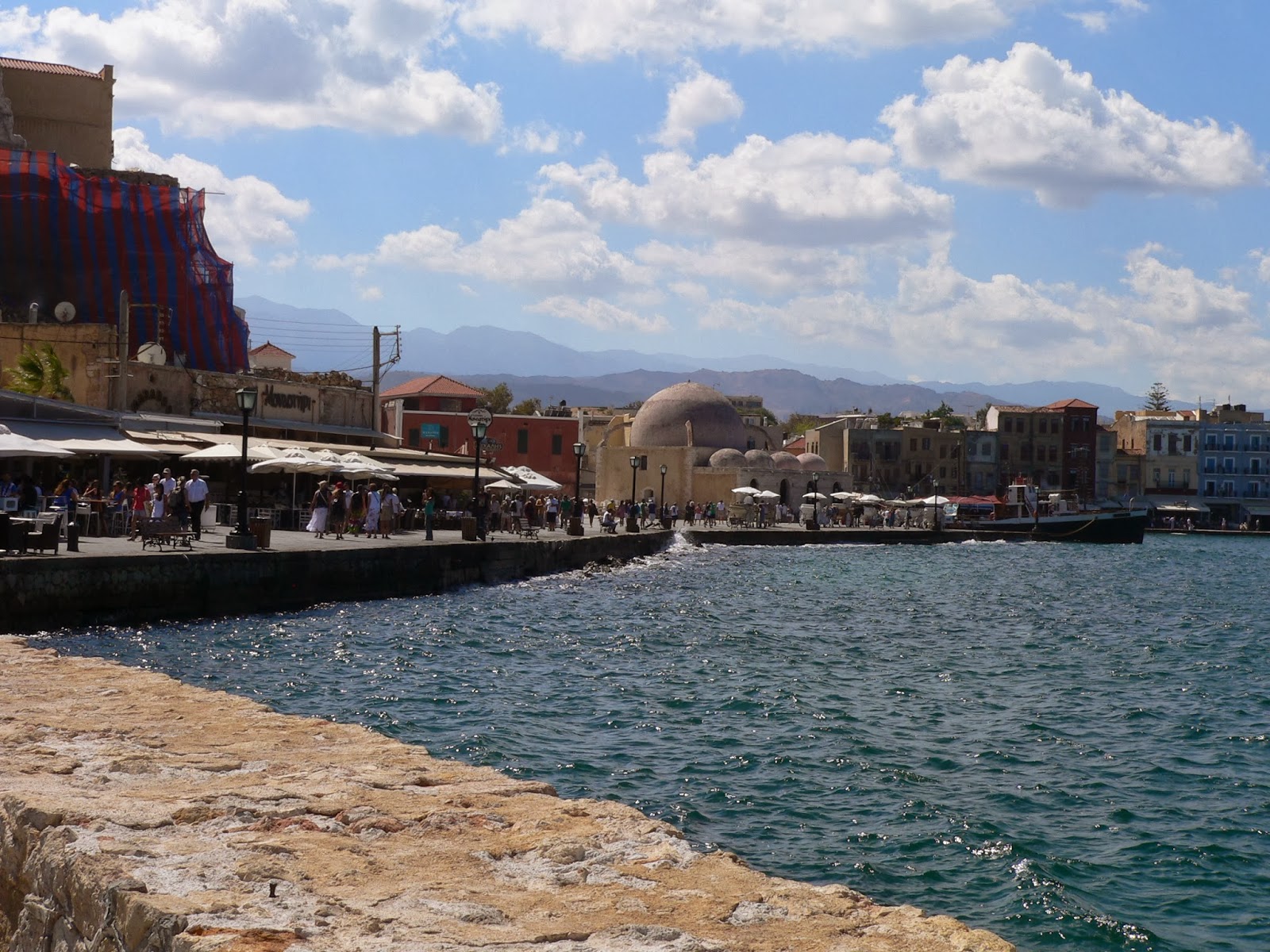 |
| |
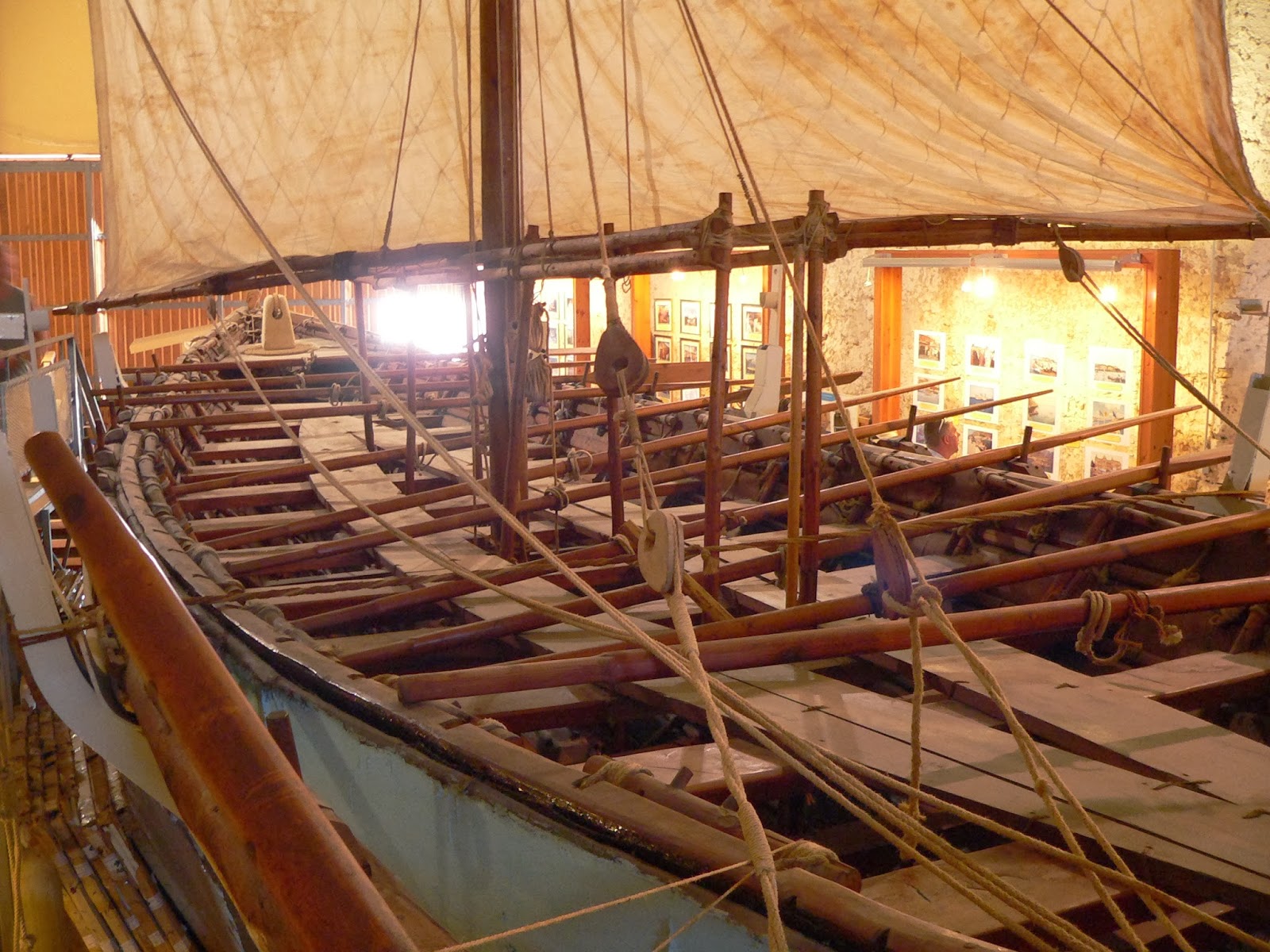 |
Chania was our first stop on Crete and we were enchanted. We wandered happily around the harbor and old town, taking pictures. On my own, I wandered into the Maritime Museum housed in the old Venetian shipyard. |
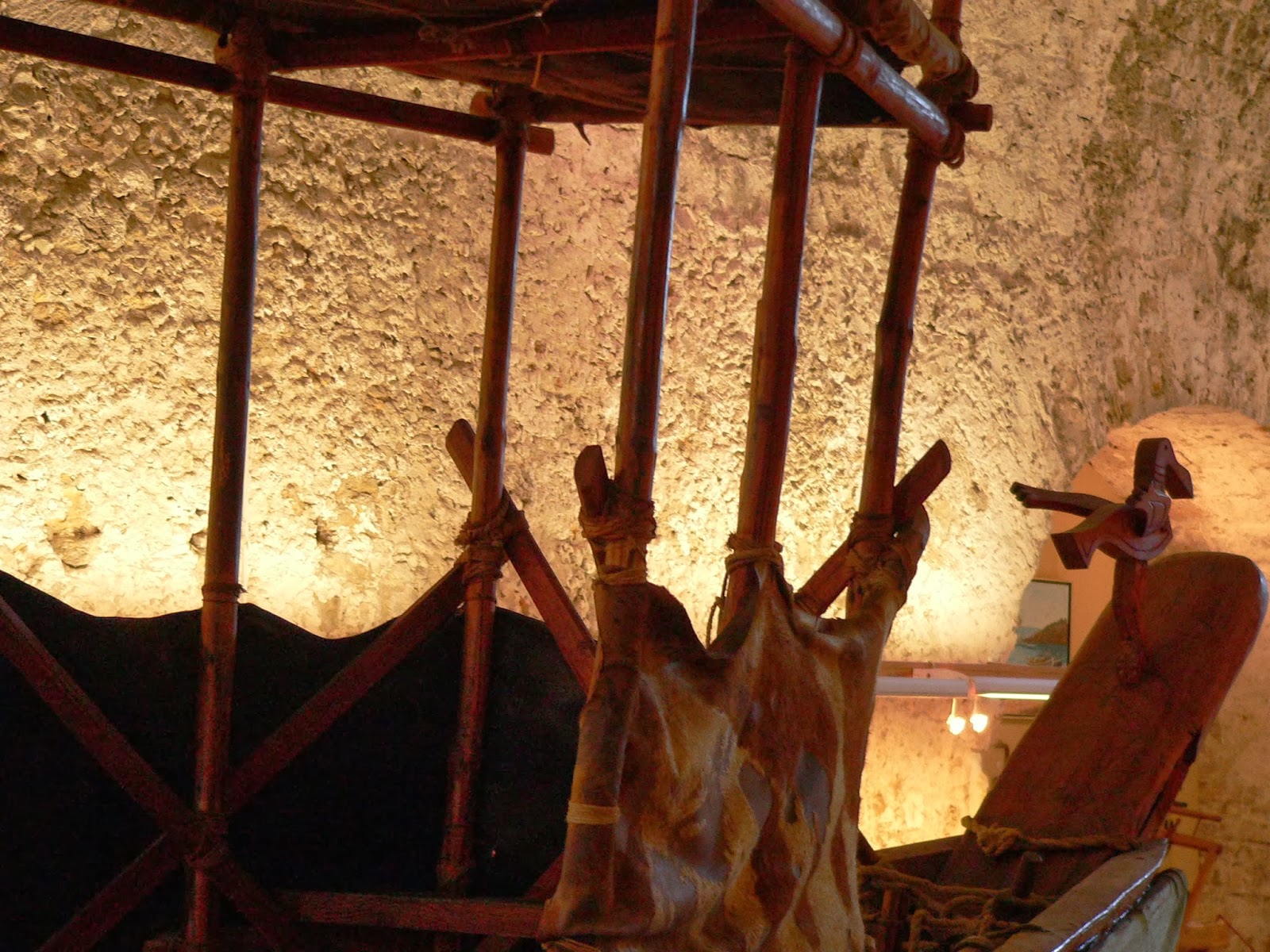 |
There, amazingly, was a full-sized recreation of a Minoan sailing vessel. I walked around its exterior, noting the plank benches for 24 oarsmen, the two long poles for steering and the captain's chair, protected by stretched hides. |
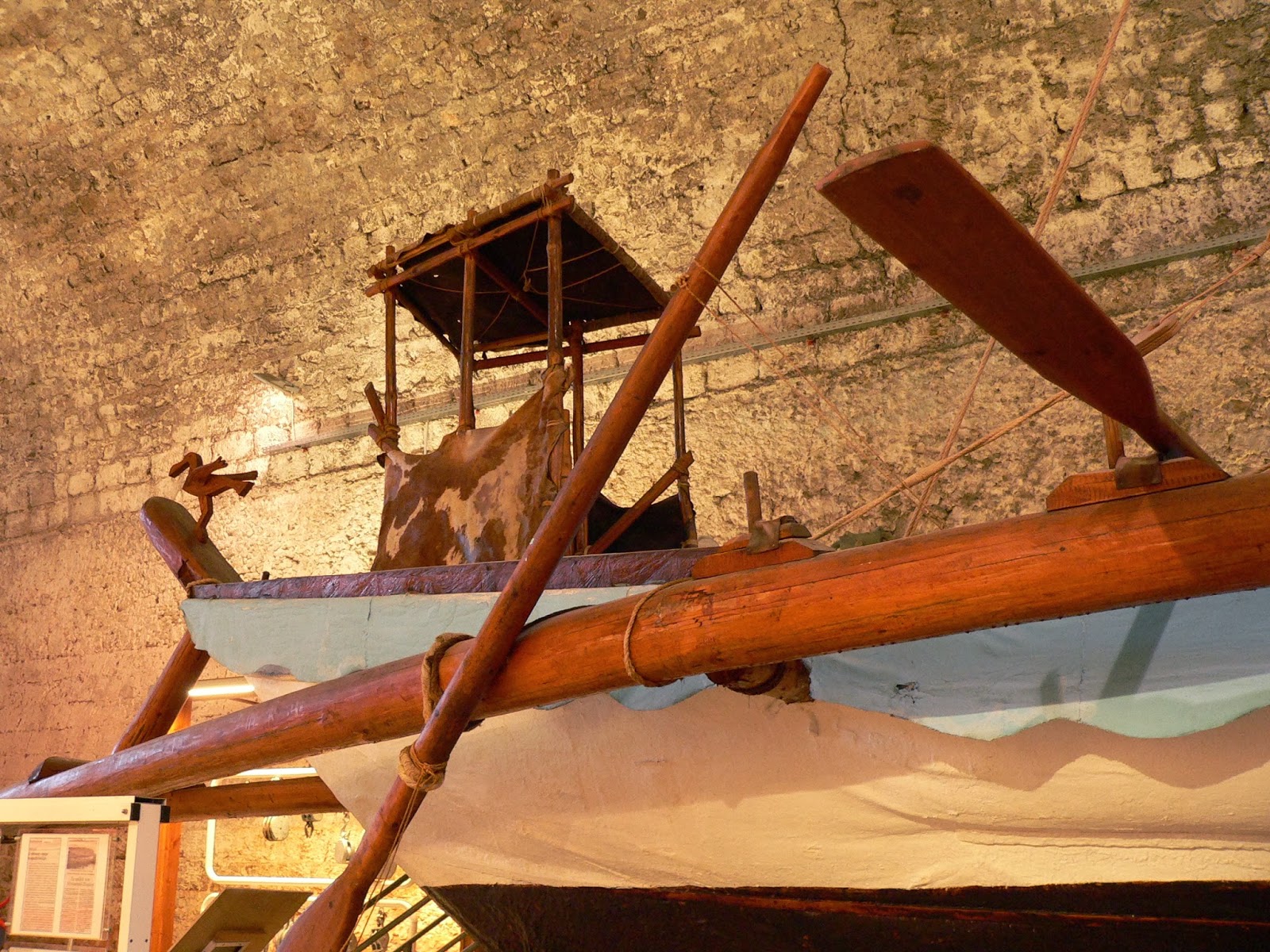 |
The reproduction, based on depictions on the walls of Minoan temples, was created for the 2004 Olympics and was actually rowed/sailed from Chania to Athens for the opening ceremonies. Its basic structure was cyprus planks covered with resin and canvas, then whitewashed. |
Circumnavigating the ship, I could imagine it circumnavigating the Mediterranean 3,500 years ago. Did a vessel like this actually cross the Atlantic? I cannot say. I can say it moved me across millenia into a deeper appreciation for the aesthetics and technology of a people whose history is recorded only in fragments of splendor. |
| |
On the second day of the "Goddess Pilgrimage in Crete" (www.goddessariadne.org) we stopped at the Paliani Convent. The complex is built around an ancient myrtle tree, thought to be at least 1,000 years old.
|
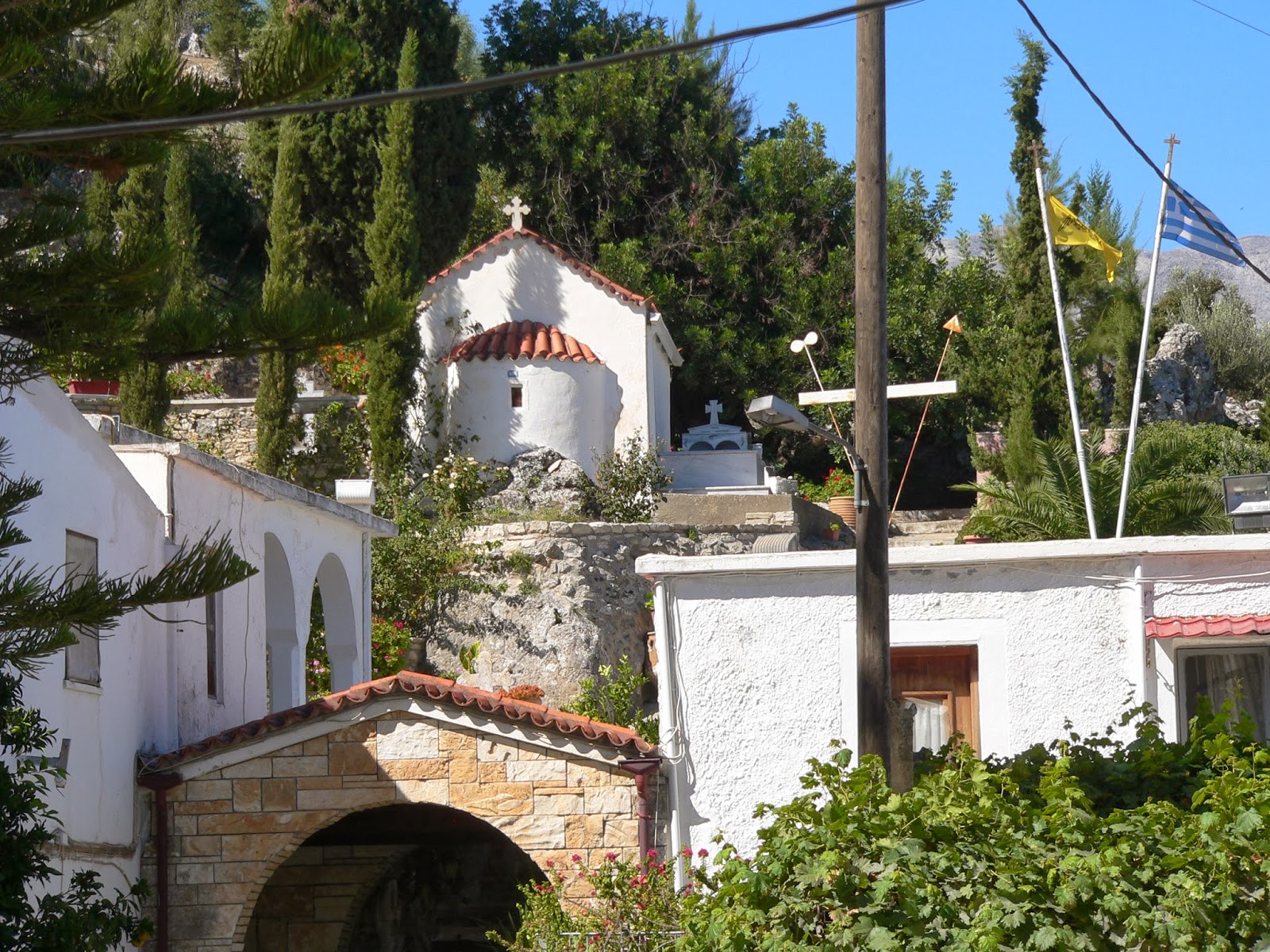 |
| |
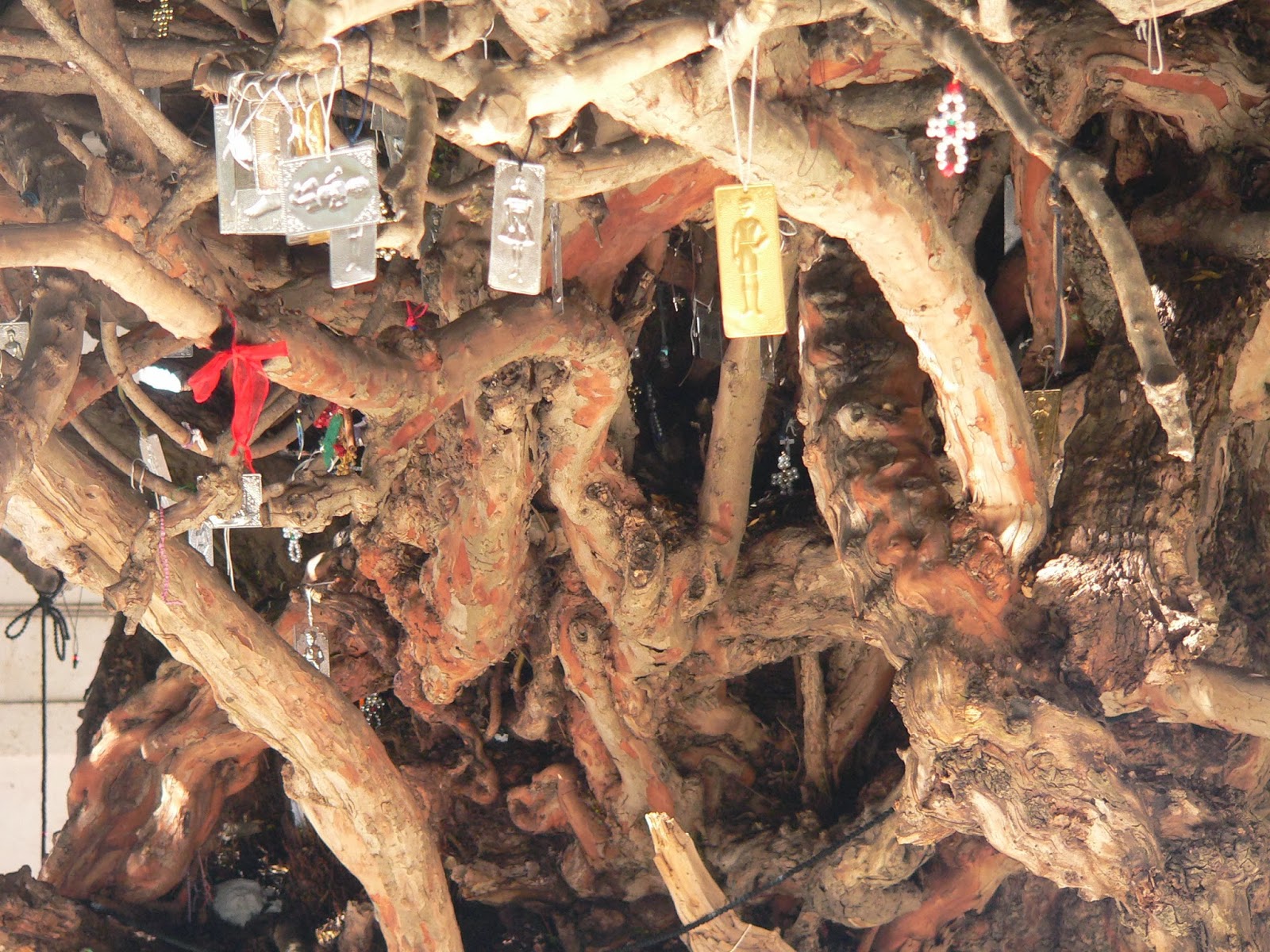 |
My back had gone out the day before so I was using a cane. One of the nuns, seeing me hobble along, called out and, through gestures, offered the loan of an aluminum walker. I declined with a smile and wave and made my way to the courtyard where the ancient tree stands, partly encircled by a stone bench.
There's a great story about this tree. When the convent was founded circa 600 CE, the founders hung an icon of the Madonna and child in the tree while the chapel was being built. When the chapel was complete, they brought the icon in . . . and the next day found it back in the tree. This happened again and again until finally they gave up and left the icon in the tree. And the tree grew around it.
Today that tree is venerated as the Holy Myrtle, dwelling place of Panagia Mirtidotissa (Virgin Mary of Myrtle). For uncounted decades, people have hung symbols of their prayers from its branches.
|
| |
Our group sat on the bench and each of us selected two pieces of ribbon. Then after a reading and songs, we each tied one piece of the ribbon on the tree, saying a prayer aloud. The other, we tied on a twig that we found in the area. As each woman tied her ribbon on the branches, we sang our wish that she, and all manner of things, would be well. |
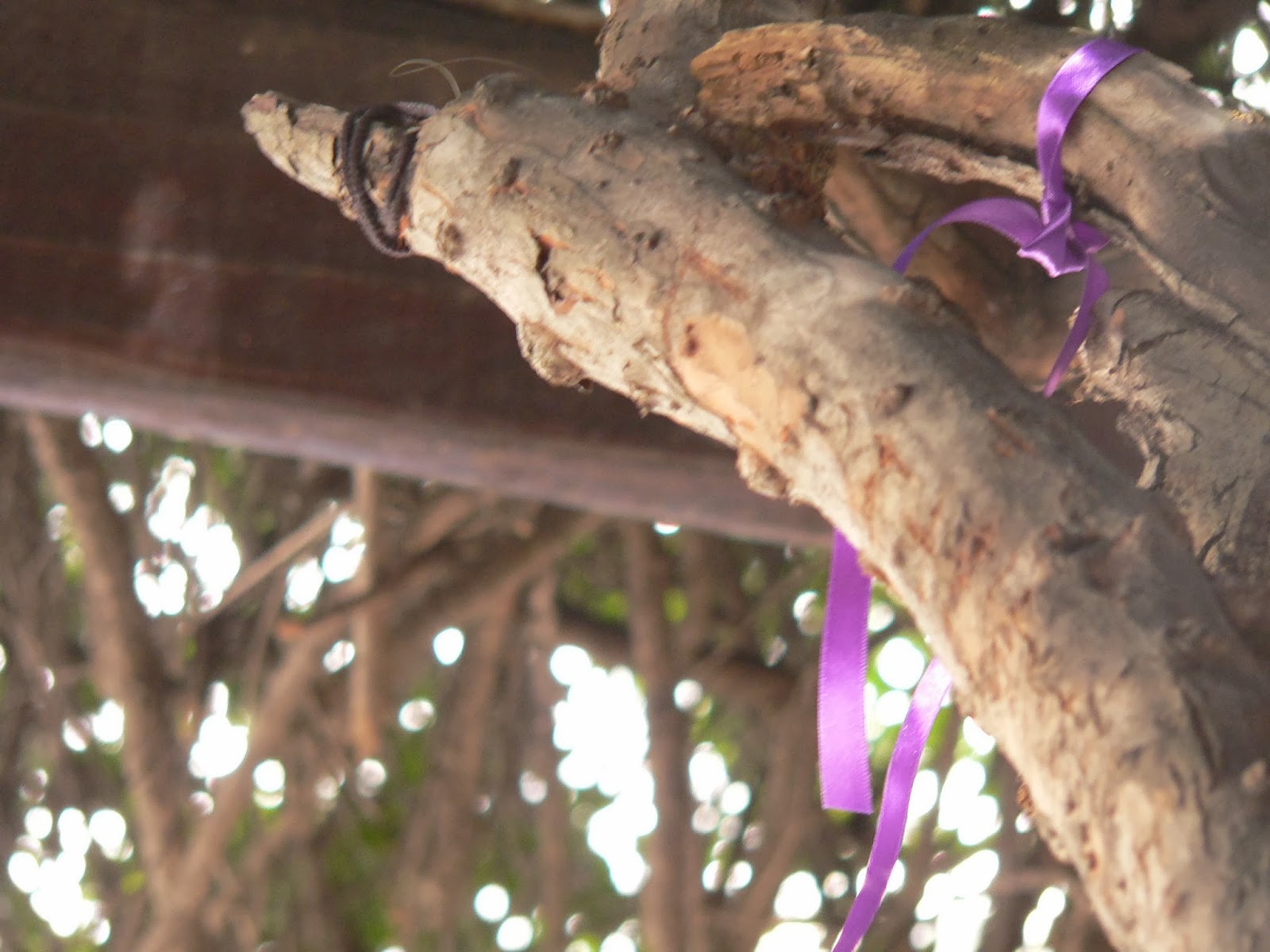
|
After our ceremony, many of us walked to the cell of the same nun who had offered me the walker. She sold little icons and black elastic bracelets adorned with colored beads. I selected one bracelet with a bead the same color as my prayer ribbon and wore it for a month before it began to wear out and I rested it on my home altar. The twig with its ribbon now rests downstairs next to an image of a Neolithic snake goddess (whose story I will tell another day).
Each memento rekindles the gentle awe that permeated the convent . . . and me.
|
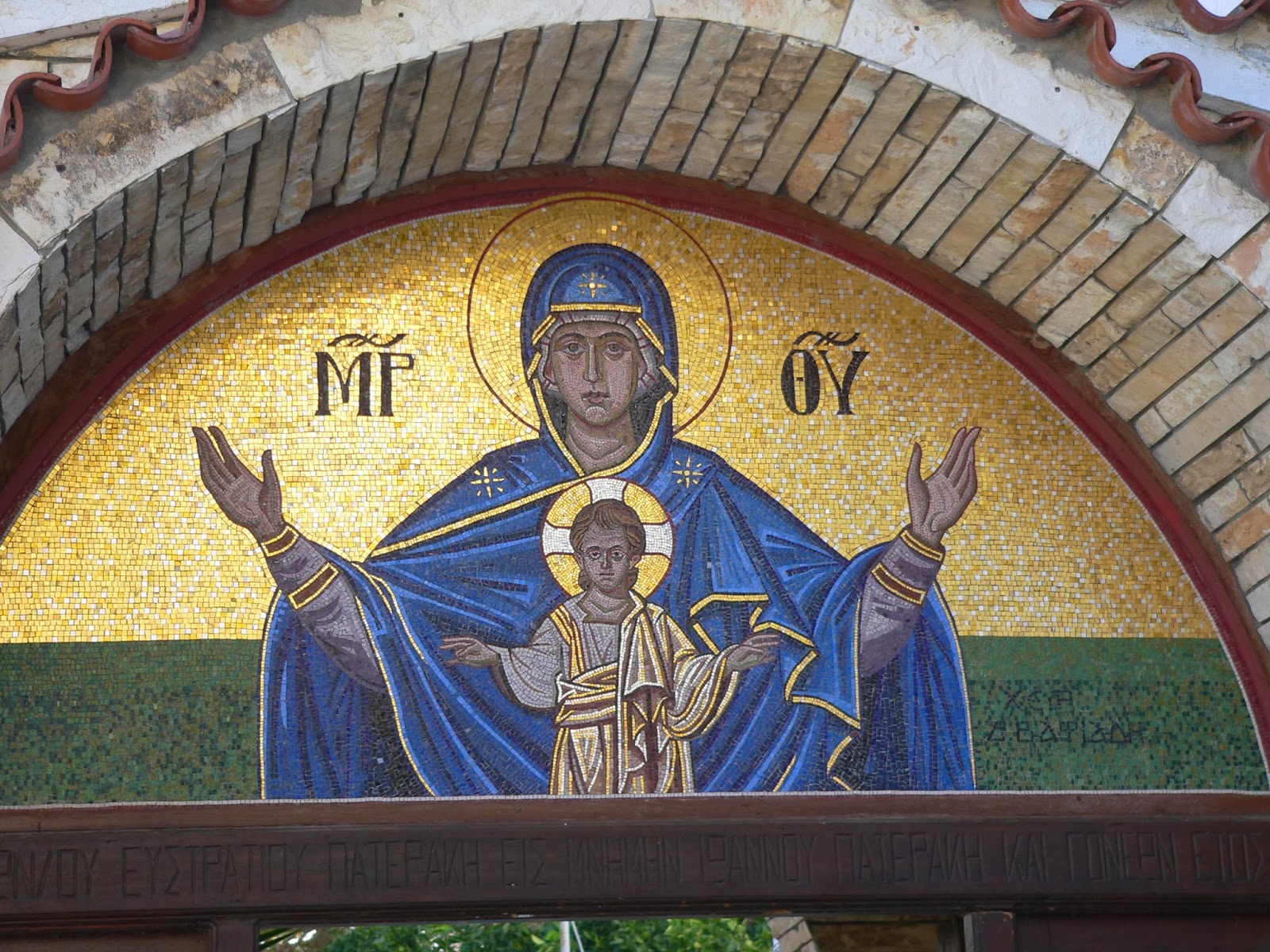 |
| |
Zorba Was Wrong
I just watched a Netflix movie: Zorba the Greek.
Because it is set in Crete and I recently returned from Crete, I rented it even though I’d seen it before. I remember thinking it was great. This attractive older Greek, irrepressible, connects with this attractive younger Englishman, repressed. And the Englishman learns to dance.
So. When I first saw the film, I too was repressed. It was a good object lesson.
However, when I watched it again, I noticed something important. The character played by Anthony Quinn uses women. When his companion dies, he rescues the woman’s parrot but does not honor her memory. And when the character played by Alan Bates connects with a woman, she dies (killed by crazed villagers).
What was Nikos Kazantzakis thinking? |
| |
In Crete, I visited the plane tree in Krasi. This magnificent tree is probably 5,000 years old. Kazantzakis is supposed to have written Zorba the Greek sitting under its ancient branches.
But I don’t get it. Crete is the very ground of the feminine. Thousands and thousands of years of honoring the nurturing, creative forces of Earth and all that emanates from Earth. An entire culture that perceived the life force as feminine and good.
Today, even though they are absorbed like the rest of us into patriarchy, the people of Crete are warm and generous to each other and to strangers. They are not stupid and cruel as depicted in the film.
And yet, here, in this land of the feminine, Kazantzakis wrote a story of two men teaching each other how to be in this world …. without any regard for women. The women are used then die without being honored
And, I’m sorry. That’s wrong. The dance is for all of us.
|
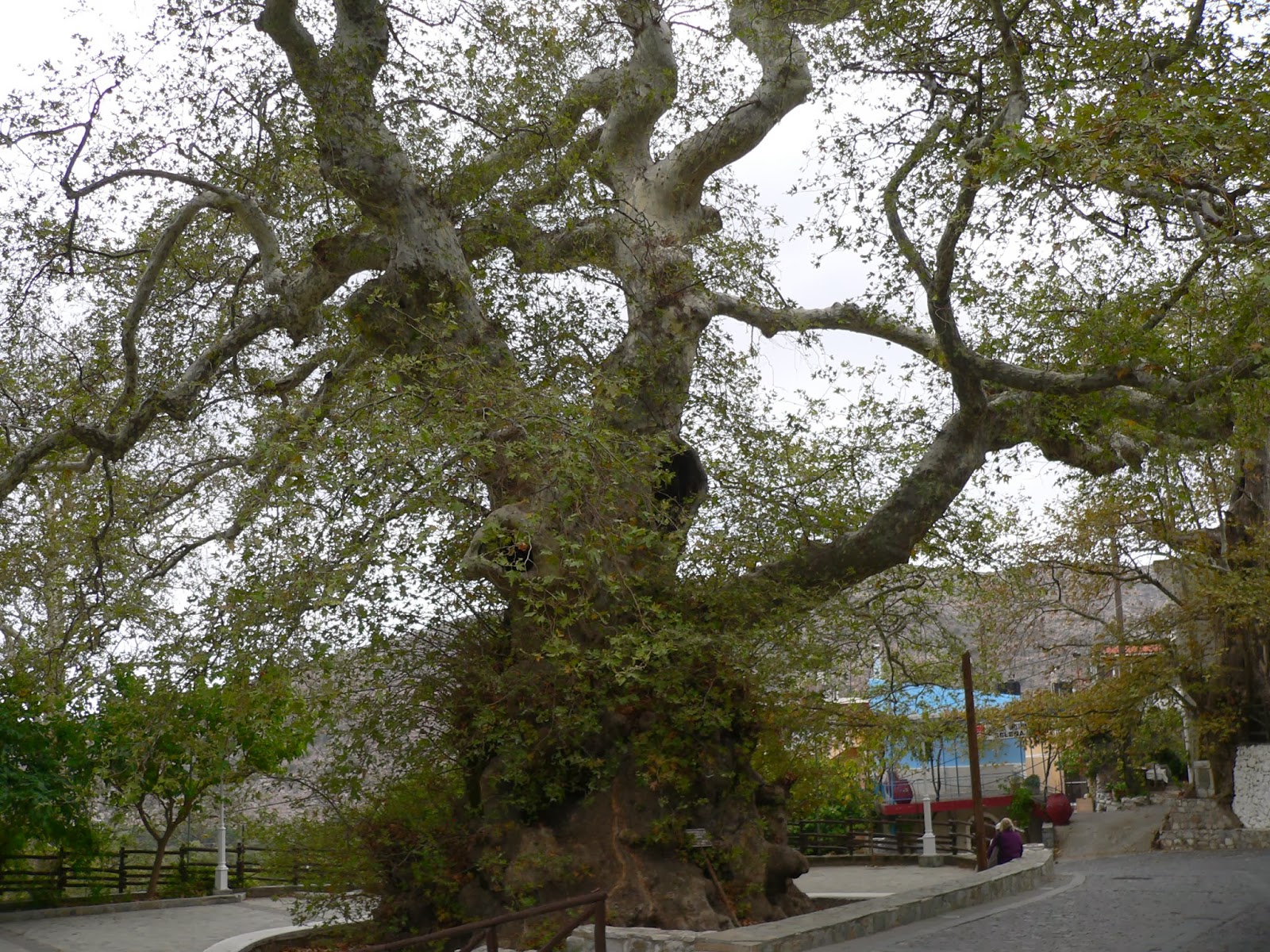 |
| |
Sacred Places
One of the things that made my recent tour of Crete (www.goddessariadne.org) so powerful was the fact that at each place held sacred by the ancient Minoan culture, we performed a ceremony or ritual acknowledging the sacredness. |
| |
Many of the sacred places were in caves (most of which I was physically unable to navigate). The one cave I managed was Elitheia outside Amnisos. A rock formation at the mouth of the cave looks like a woman giving birth. Further back in the cave, stalactites and stalagmites evoked images of maternity. As we entered, someone placed an egg in the ‘navel’ and each of us poured libations on the formation before proceeding further into this homage to womanhood – accompanying each stop with poetry. I could not help but note that others had been there before us. Fresh flowers surrounded the birth rock.
|

|
| |
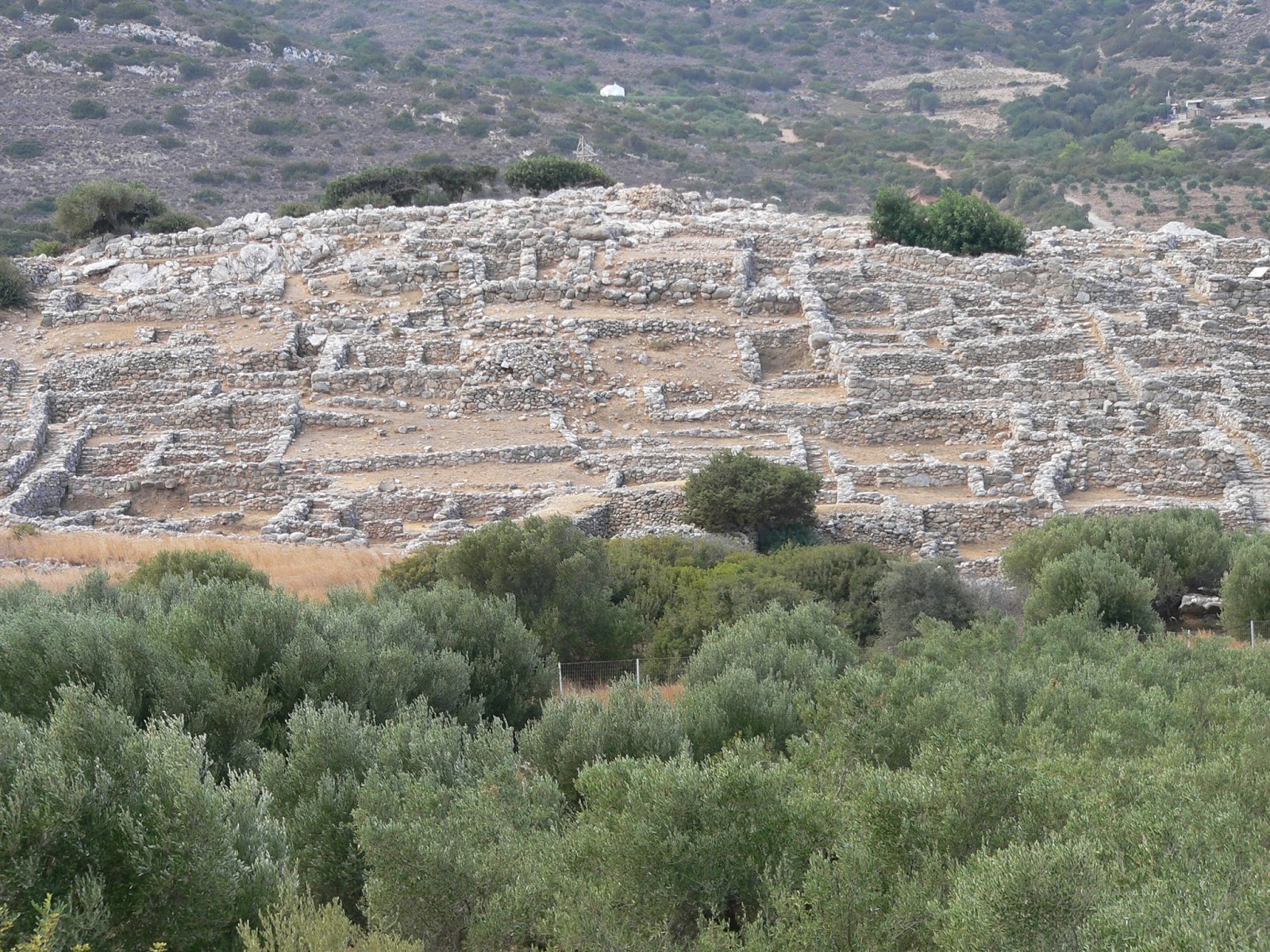 |
Later, we went to Gournia, a completely excavated Minoan town.
|
| |
Like all Minoan settlements, it had a sacred center, a stone in a courtyard where the holy was acknowledged. There, we placed fruits on the perimeter of the sacred stone and, after readings, fed the fruit to each other.
|
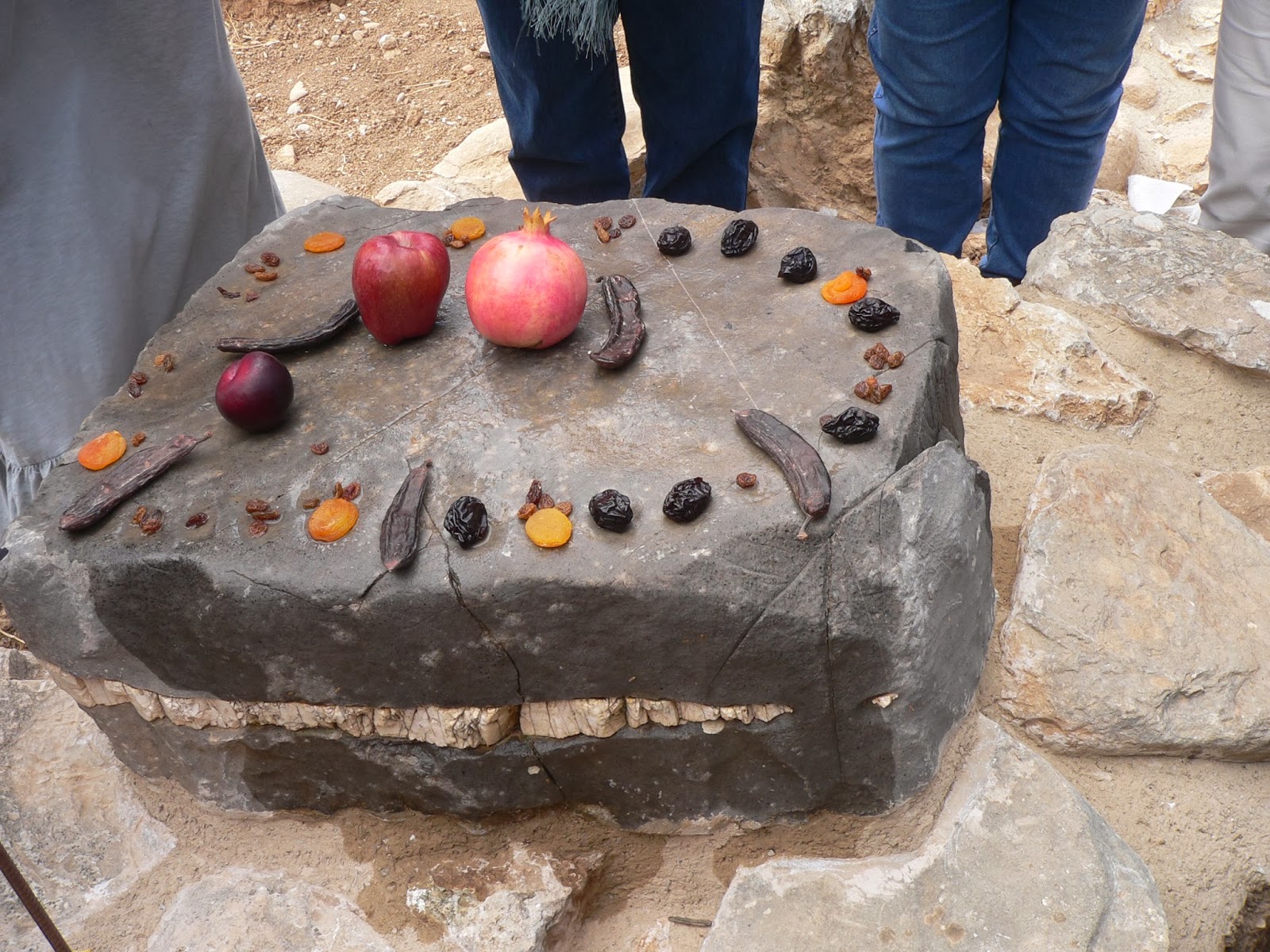
|
| |
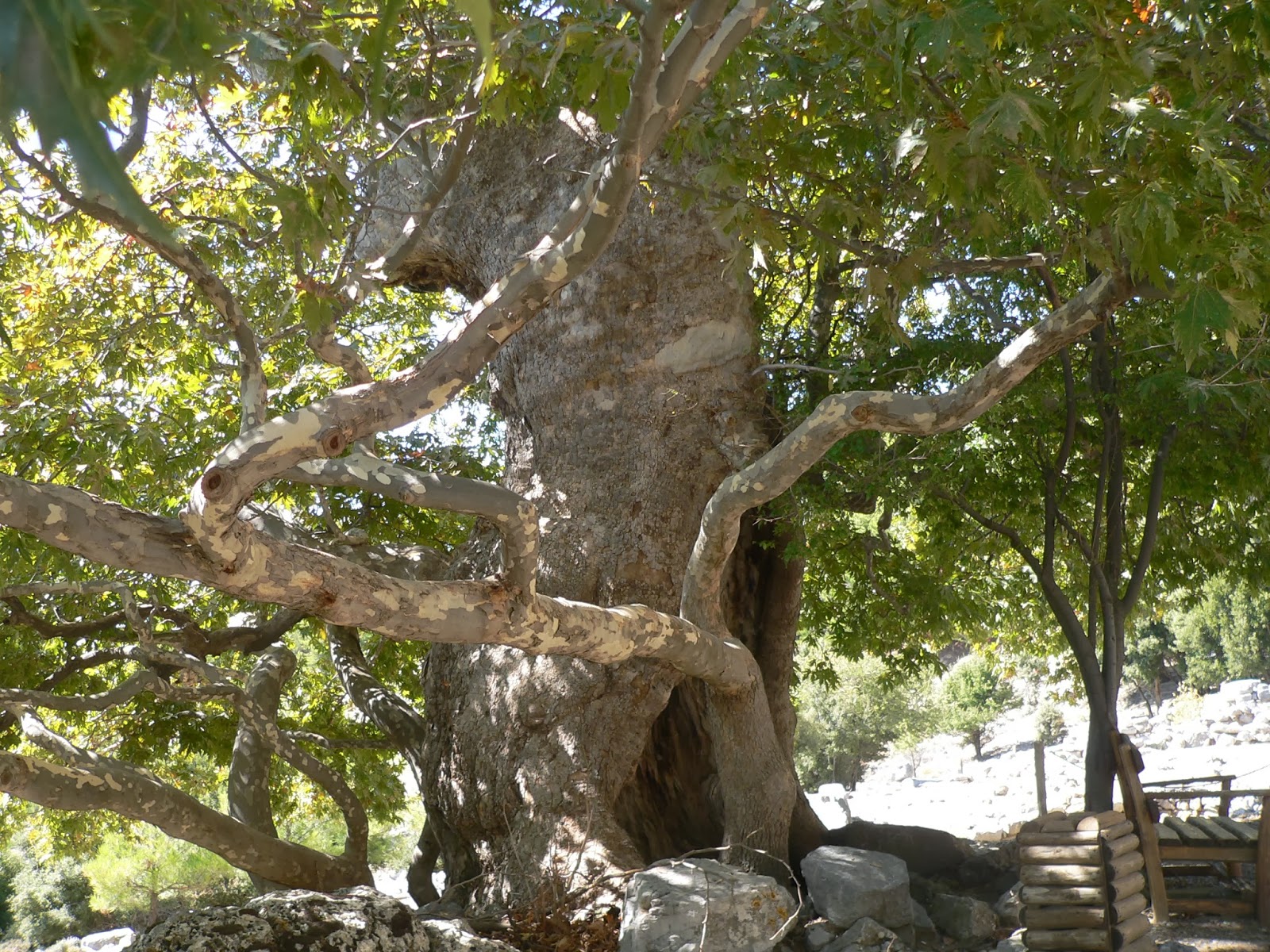 |
On another day our bus stopped outside the Aphrodite Tavern in Kato Symi. It could not take us the rest of the way up the mountain. We transferred into two pickups and went vertically to a mountain peak shrine where a sacred spring watered a magnificent tree (and goats literally gamboled on the surrounding rocks). We gathered in a circle, taking turns reading Saphho poetry. It was magic. Then we clambered back into the pickups and descended. The afternoon was crowned by a feast at the tavern. |
| |
Each site, each ceremony connected me with a civilization that honored women and the earth. And with the rich heritage each human holds within her DNA and psyche. |
| |
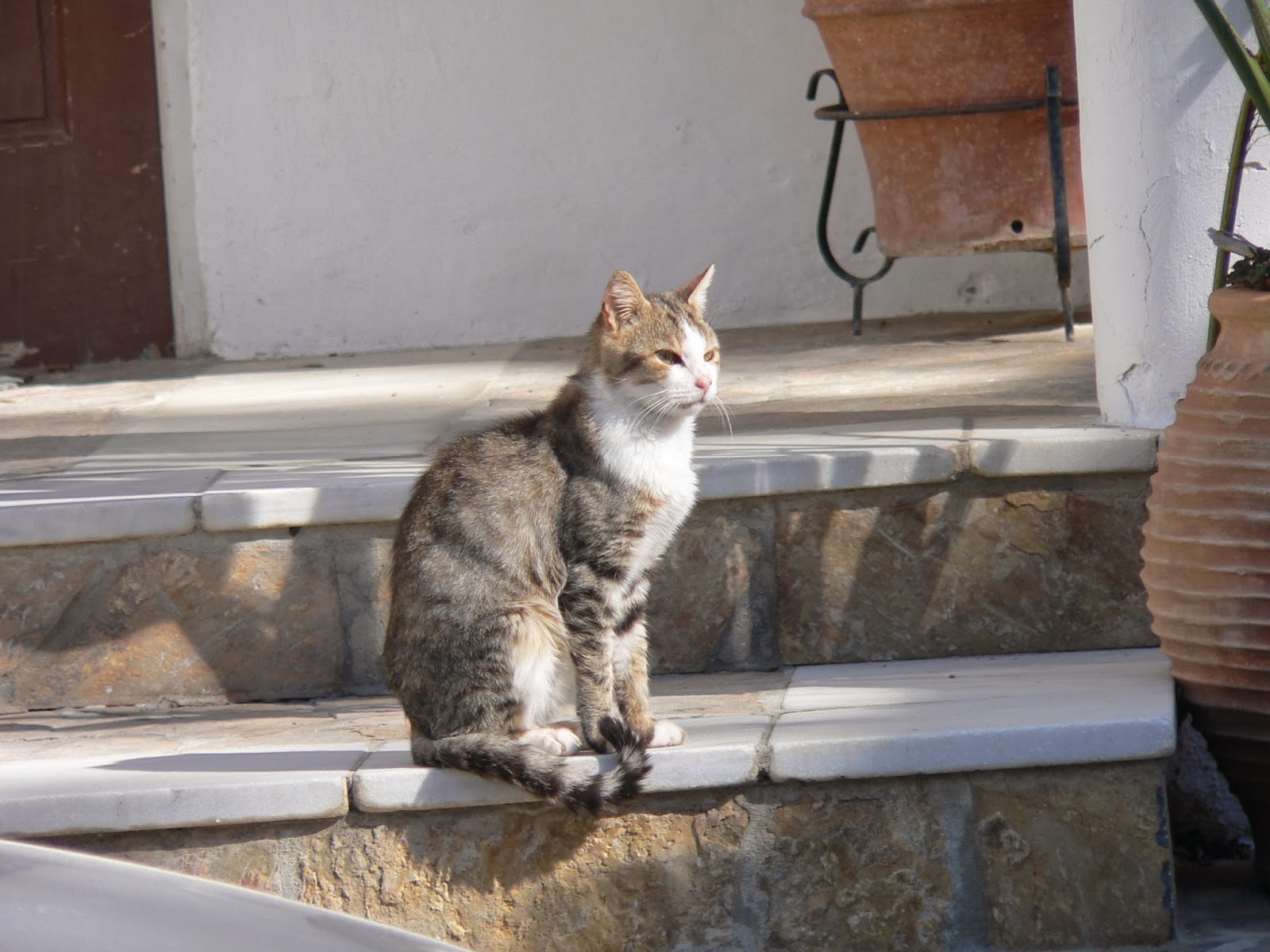
|
Cat Encounters in Crete
Cats were one of the first things I noticed in Crete. In Chania, our first stop, there were lots of cats. They seemed well fed. They were not intrusive, just ubiquitous. And every little store with postcards and souvenirs carried images of cats.
I only took a picture of one. This one lived at the Paliani Convent which is built around a Holy Myrtle tree. |
| |
I never managed to photograph the cats with whom I had a special connection. I was on a goddess tour (www.goddessariadne.org). Led by Dr. Carol Christ – scholar, author, and theologian -- we honored the sacred at each site that had been sacred to the Minoan people and their descendants.
At the convent, we sat on a stone bench curving around the ancient tree and sang a response as each of us tied a piece of ribbon on the branches with a prayer. There, a little black cat hopped onto my lap to comfort me.
I don’t remember now whether it was at Phaistos or Malia – two of the ancient Minoan sacred centers we visited – but a little white and brown cat followed me, jumped on a bench when I asked it to (how did it know English?) then gave me a good-bye head bump as I was leaving.
There were other cats – a tri-colored kitten in Mochlos, a beautiful little fishing village, and the cat I fed French fries in the Anoglia tavern. But the most amazing was the little black cat who guided us around the Minoan ruins in the town of Tylissos.
We had had a wonderful visit to the home of Marie and Stella who shared refreshments and stories before we moved to the ruins of a Minoan village around the corner. As we entered the complex, the little cat trotted up and walked with us as we walked and sat with us when we sat.
[Actually I do have sort of picture of him, climbing onto Mikai’s shoulder.] |

|
| |
As we were leaving the complex, a family was just entering. The cat abandoned us and trotted up in front of the new group. Evidently, he was the official guide.
Who could ask for more? |
| |
My Goddess
Here she is. A terracotta Neolithic Snake Goddess from circa 4,500 BCE. She's just under six inches high and protected in a glass case at the Heraklion Archaeological Museum in Crete.
To me, she is a symbol of the millennia during which women were honored and society was more egalitarian and peaceful.
For more than 1,500 years, Crete thrived without invasion, evolving from a Neolithic society to a Bronze Age civilization (the Minoan) that managed to retain its belief in the unity of life -- and the sacredness of this planet.
It inherited the Neolithic culture of Old Europe which established these patterns as early as 7000 BCE.
I met the Snake Goddess on the first full day of the Goddess Tour of Crete led by Dr. Carol Christ (www.goddessariadne.org). She, amid all the treasures in the museum, was the item that bowled me over.
Later, in one of the shops across the highway from the ruins of the Knossis Palace (or sacred center) I bought a reproduction. I carried her around to all the sacred places we visited. Often, we would have ceremonies during which we honored our individual goddesses with libations. I poured honey over mine so she is, even after several washings, a bit sticky.
Nonetheless, I honor her. I found a spot on the east side of my house where she now sits under a glass tree sculpture next to my twig from the sacred myrtle tree at the Paliani Convent.
I still have not absorbed her import. Intellectually, I know that human civilization moved on. After more than 5,000 years of matrilineal communities, we took another 3,000 years to develop great literature and perpetual war on each other and the Earth.
As I sift through my memories and emotions, she remains -- serene and silent in my living room. Waiting, I think, for me to figure it out.
Or perhaps for all of us to figure it out. |
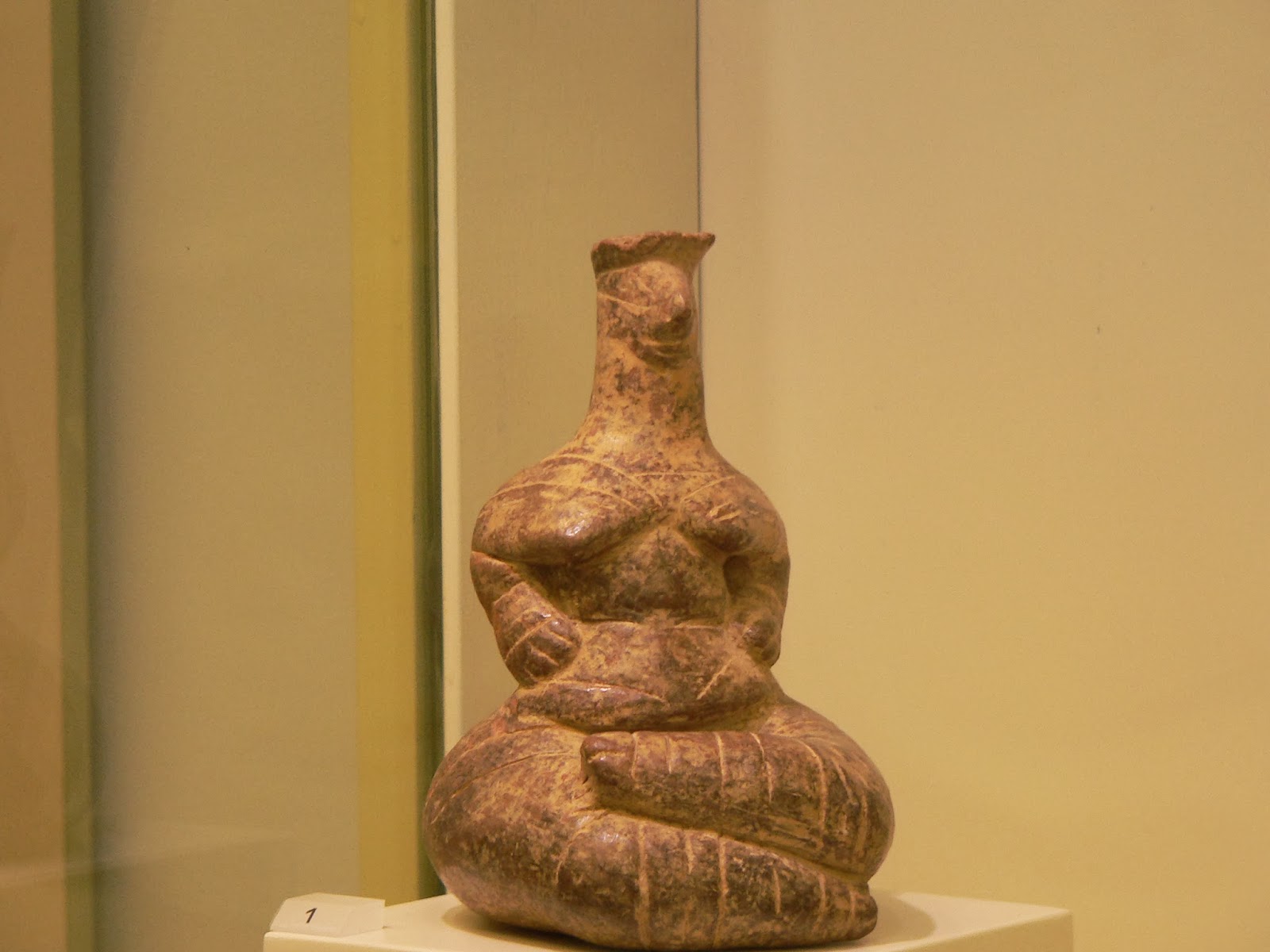
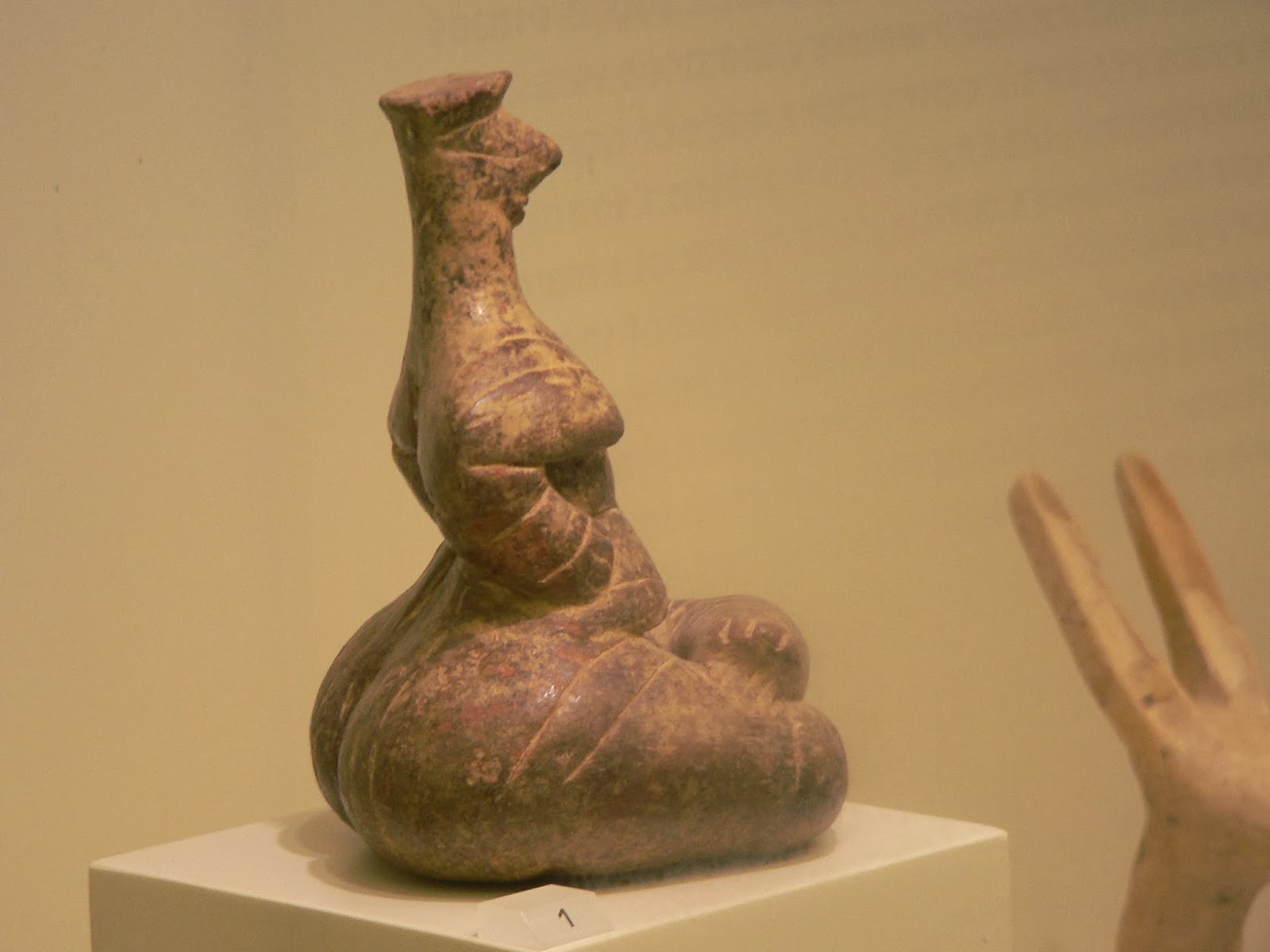
|
| |
A Story in Three Images
I’m just making this up but when I was in Crete on a goddess tour (www.goddessariadne.org) led by feminist theologian and scholar Dr. Carol Christ, I saw three female images that could, perhaps, tell a story.
|
| |
One, in the Archeological Museum in Heraklion, was a statuette of a Minoan priestess, vibrant and powerful. |
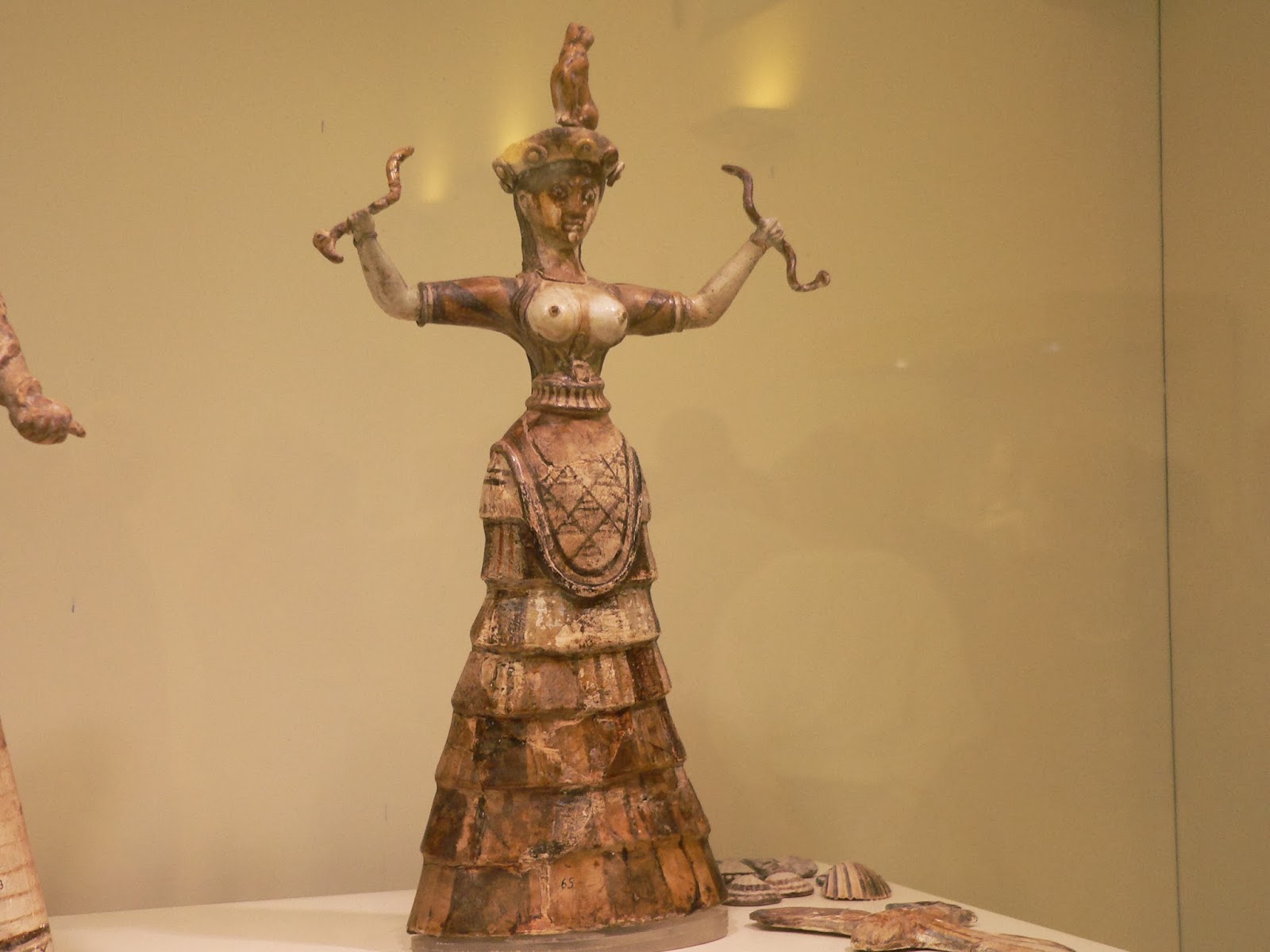
|
| |
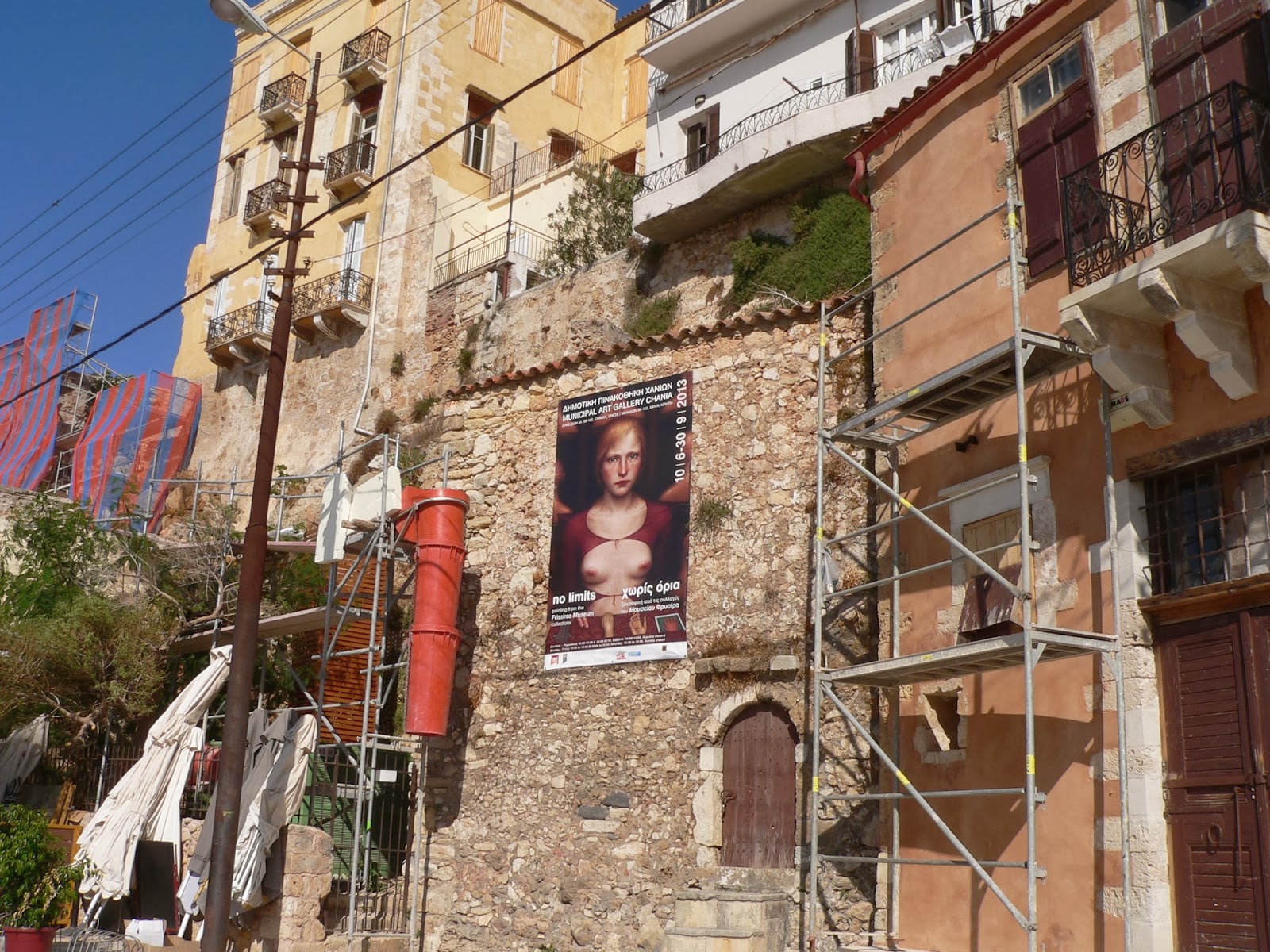
|
Another, on a gigantic poster on a square in Chania, depicted another bare-breasted female who appeared deeply sad. Why? |
| |
On the way out of a small city where we had marveled at a museum's examples of ancient art, Dr. Christ pointed out this sign (I only had a few seconds to photograph) outside a grocery store.
The Goddess Ariadne, who probably migrated with Neolithic settlers from Anatolia some seven thousand years ago, was now transformed into the symbol for a grocery store chain.
I would be sad too. |

|
| |
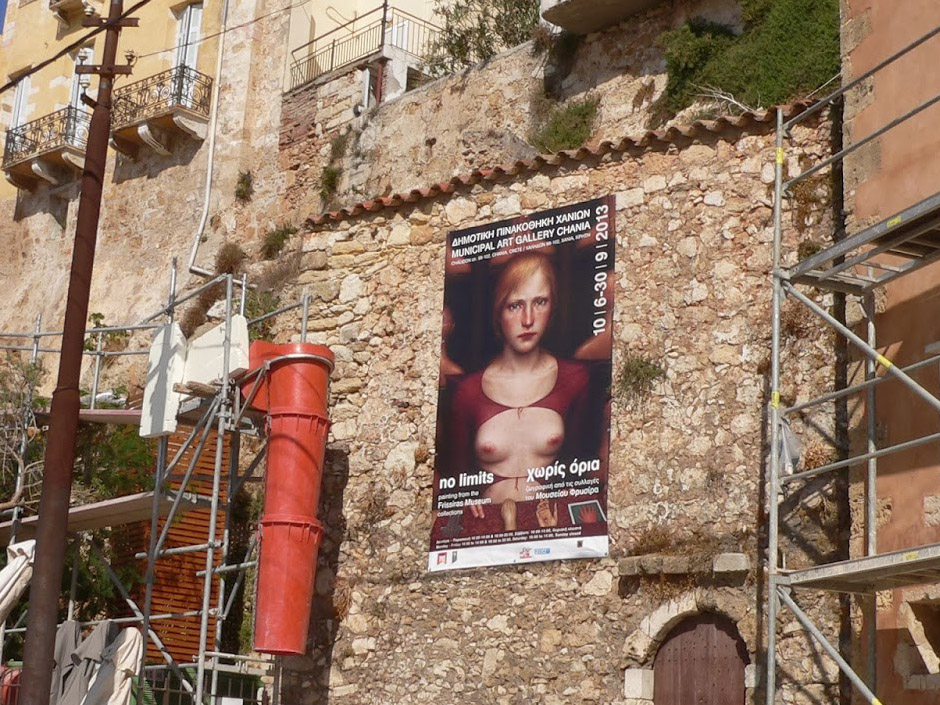
|
Graphic Reminder
If I knew how to 'photo-shop' I might edit out the scaffolding, etc. surrounding this giant poster that was hung on plaza in Chania, Crete. But perhaps all the debris is appropriate. And, yes, I know I used this image in a previous post but I think you need to get used to it. I believe I will use it whenever I encounter something that denigrates women. I may have to use it a lot.
The other night I saw the documentary "The Invisible War" on PBS. I happened on it by chance and stayed with it, mesmerized by the enormity of the dilemmas faced by women (and men) in the U.S. military who have been raped by other members of the U.S. military. I had seen occasional headlines about this issue but I hadn't learned any of the personal stories. And the personal stories are horrific.
During the fall Goddess Tour of Crete (www.goddessariadne.org) led by feminist scholar and theologian Dr. Carol Christ, I was imbedded in a supportive female culture. Hampered by back problems, climbing over and into ancient Minoan ruins was daunting. But wherever we went, the other women on the tour held out their hands and offered whatever I needed. It was just the way we were. It was just the way we understood the ancient Minoan culture to be. In our evening circles, in our morning chants, in the ceremonies we performed in sacred centers, we reinforced these actions with words.
We honored each other.
The transition back into a culture where people do not honor each other, where rape goes unpunished, where violence dominates the headlines, can be (is) difficult and overwhelming.
I am beginning to emerge. Beginning to move back toward wholeness. In future posts, I will reveal how that might be possible. But every once in a while, you will see this photo again -- when once again, women (and/or men and/or children and/or other living things and/or our planet) are denigrated.
Because we need to acknowledge the wrongs or we will never get it right. |
| |
There Were 16
There were 16 of us – two leaders and 14 women from various English-speaking countries – who participated in the Sept. 28 – Oct. 11 goddess tour of Crete (www.goddessariadne.org).
We gathered for the first time Friday evening, Sept. 28. The chairs were in a circle. Each of us was asked why we had chosen to participate and each of us was asked to say: I am here, I am whole, I am [and then our name]. It seemed somehow presumptuous, but we all did it.
During the course of the pilgrimage we often gathered in the evening, always in a circle. Each time, we took turns describing our perceptions of what had occurred that day, after we said: I am here, I am whole, I am [name].
Such a simple practice. But that practice, coupled with the morning blessing that we tried – with varying success – to repeat en route to whatever marvel was on our day’s agenda, wrapped us into community.
[The morning blessing was longer and only partially memorized – and, inevitably, by the time I found the written version, it was over. Still, it framed the day.]
Singing
The breath of my spirit will bless
the cells of my being sing
in gratitude, reawakening. . . .
Reciting
This earth is my sister
I love her daily grace her silent daring
and how loved I am
how we admire this strength in each other
all that we have lost, all that we have suffered all that we know:
we are stunned by this beauty and I do not forget:
what she is to me, what I am to her.
Singing
As this day dawns in beauty, We pledge ourselves to repair the web.
Circles are powerful. Often, when we gather looking into each others’ faces, we glimpse each others’ hearts. Ritual is powerful. Things repeated on a regular basis can work their way into our psyches.
Framed thus, our experience of the matrilineal Minoan culture deepened. I, for one, was able to perceive the divine feminine, to experience what it might be like to all that I could be as a woman, as a crone.
I am here, I am whole, I am Mim |

|
| |

|
Blueprint for human dignity
Look closely at the ruins of the ancient Minoan town of Gournia. To me, they illustrate another aspect of our Cretan ancestors. These stones outline houses.
When you walk among them, you get a sense of the people. You feel invited to sit on porches, to share stories of your day. |
| |
To me, these ruins illustrate the egalitarian aspect of Minoan culture. All the houses were about the same size. (They were also two and three stories high and had a form of indoor plumbing. Not bad for three-plus millennia ago.)
Imagine, if you can, a society in which people – men and women, young and old – were more equal than they are today. A society in which dignity was part of being human. Minoan Crete was a place that honored all the components of the web of life.
What do we honor? To whom do we grant dignity?
At the summit of the hill on which this town was built there is a Kernos (sacred stone). Those of us on the goddess tour (www.goddessariadne.org) placed fruits there and, after readings, fed the fruits to one another. |

|
| |
 |
Can you digest another culture? Can walking ancient paths, sitting on ancient steps, and honoring ancient sacred sites change the way you think about your own society, your own times?
Absolutely.
Hallelujah and Blessed Be |
| |
A Moment in Crete
One of the factors that made the fall tour of Crete (www.goddessariadne.com) so powerful was the community that the participants became. |
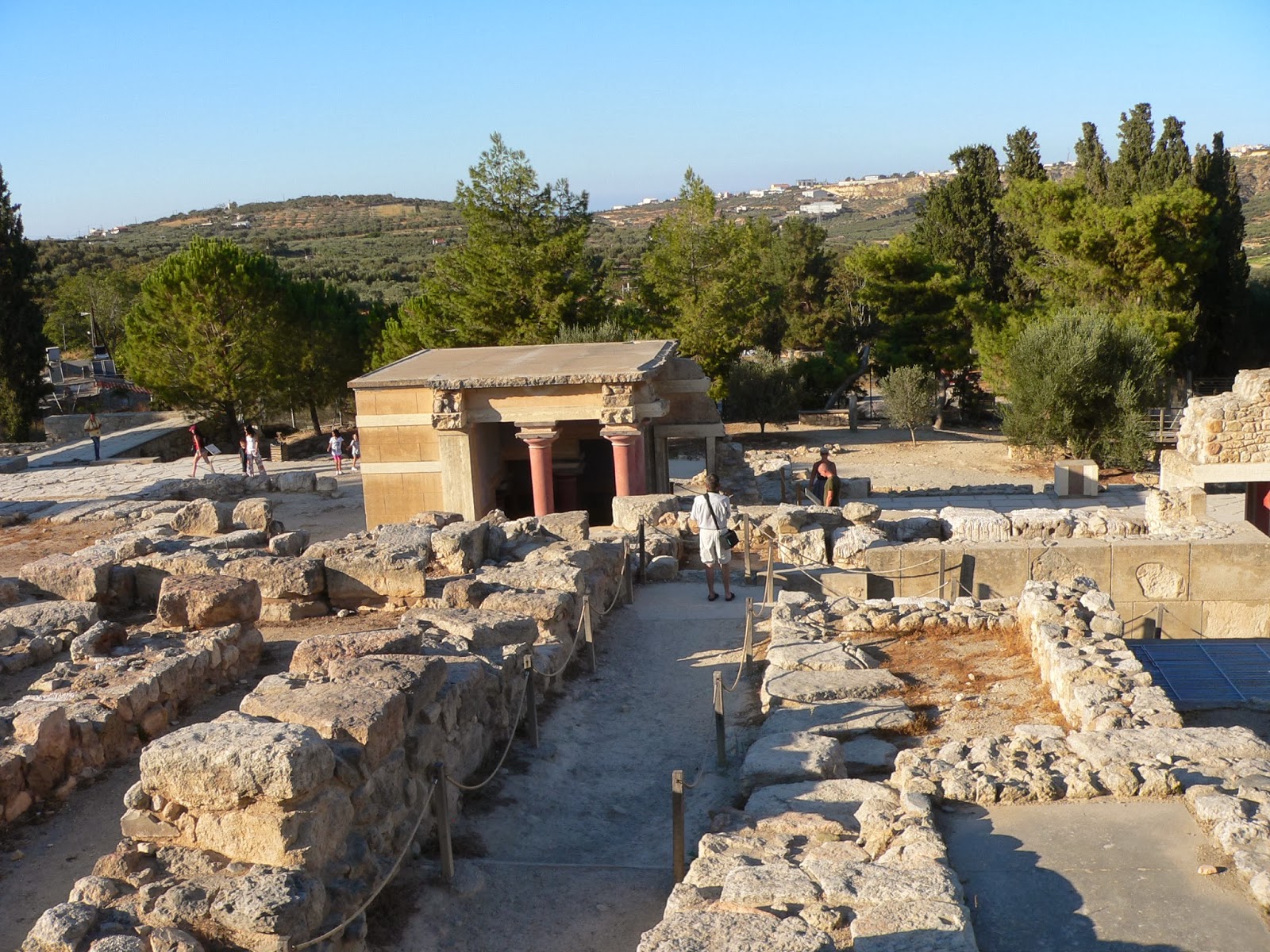
|
| |
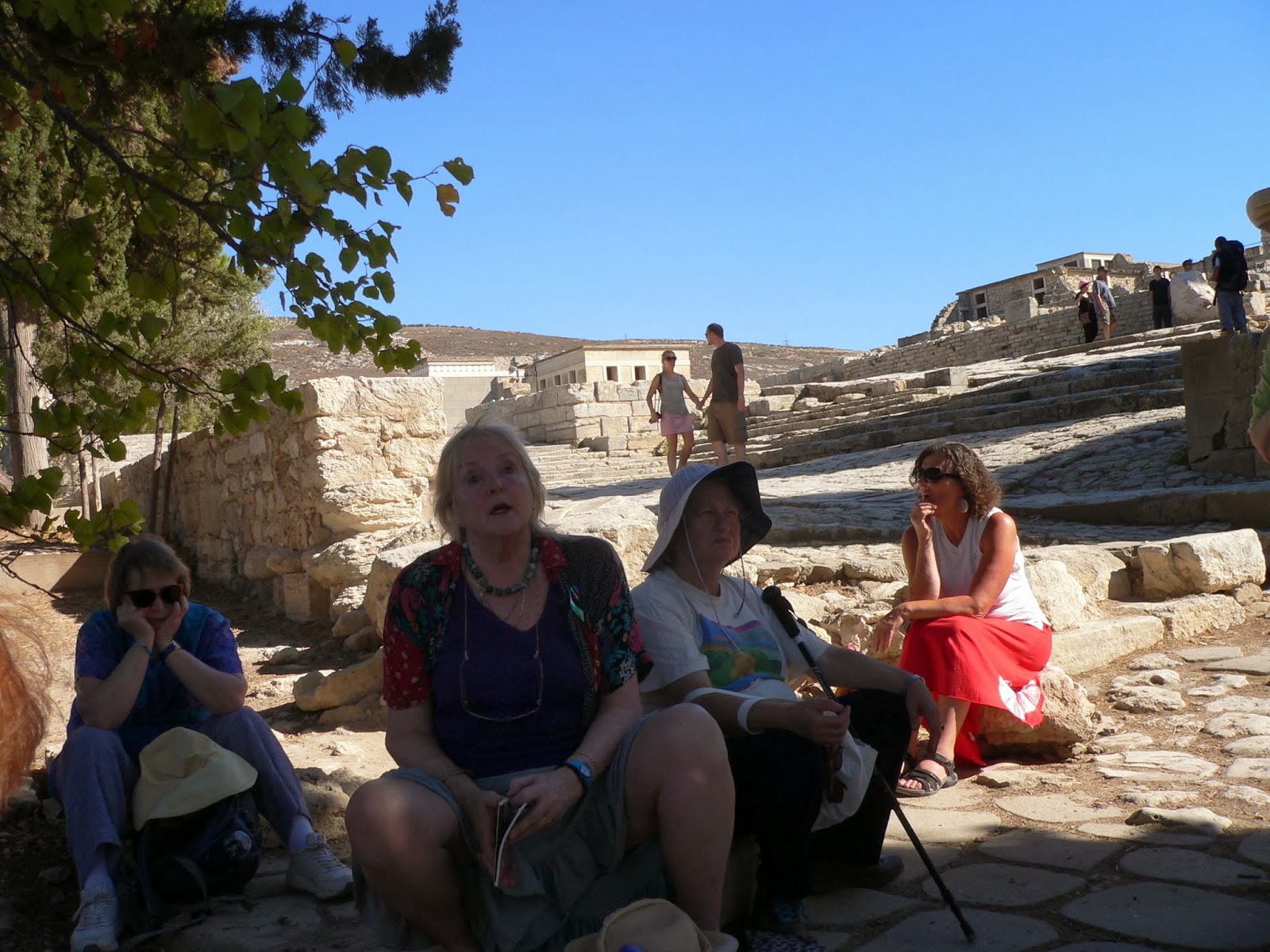
|
Often before walking a site, such as the ruins of Knossis, we would learn about its history and significance and approach it with the respect and in the manner which it deserved.
Still, one of the most powerful experiences I had, happened on the day I got lost, with one of the tour's leaders, Mika. The group was to gather at a Minoan tomb, Tholos, near Kamilari. Because of back problems, I walked so slowly that Mika and I lost sight of the others and wandered around for an hour before giving up and creating our own little ritual on the side of a dirt road, in the middle of nowhere important.
Sitting in a little patch of rocks, we set our goddess images on their mineral perches and poured our respective libations as we remembered aloud our female ancestors. I invoked my paternal grandmother, Edna Miriam Thacker McClure, her mother (my great grandmother) Nell Miriam Fowler Thacker, and the generations of prior Miriams recorded on a sampler that hangs in my guest room. The ritual prompted me to renew the honor in which I hold my own name (Miriam of course) and its heritage/ my heritage.
After the ceremony, we found our way back to the bus and eventually the others joined us and the tour continued with, as I recall, an incredible (and incredibly late) lunch at a seaside restaurant in Kamilari.
That private ceremony still reverberates in my memory. I have no pictures of that pile of rocks (my camera was temporarily jammed).
Sometimes photographs are redundant. |
| |
It’s been more than four months since I returned from the ‘goddess tour of Crete’ (www.goddessariadne.org) led by feminist theologian/ scholar/ author Dr. Carol Christ. You’d think by now I’d be ‘over it’ – that I would find something else to write about. And I will – eventually – write about other things. But I don’t think I want to be ‘over’ what I learned in Crete. Ever.
By walking amid five-thousand-year old ruins, climbing carefully into caves sacred to the Minoan people, and holding rituals around sacred stones or springs or trees, I began to have a vision of a different kind of society: a non-dominational society.
[My computer does not like that word – which I just made up – probably because it’s a pretty patriarchal machine. Let’s use it anyway.]
Oddly, since when most people think about ancient Crete (if they do) they think about the bull-leaping depicted in Minoan art and reflected in tales woven by latter-day Greeks, I did not photograph any bull-leaping art except this one clay vessel of kids dangling off the head of some bovine form. |
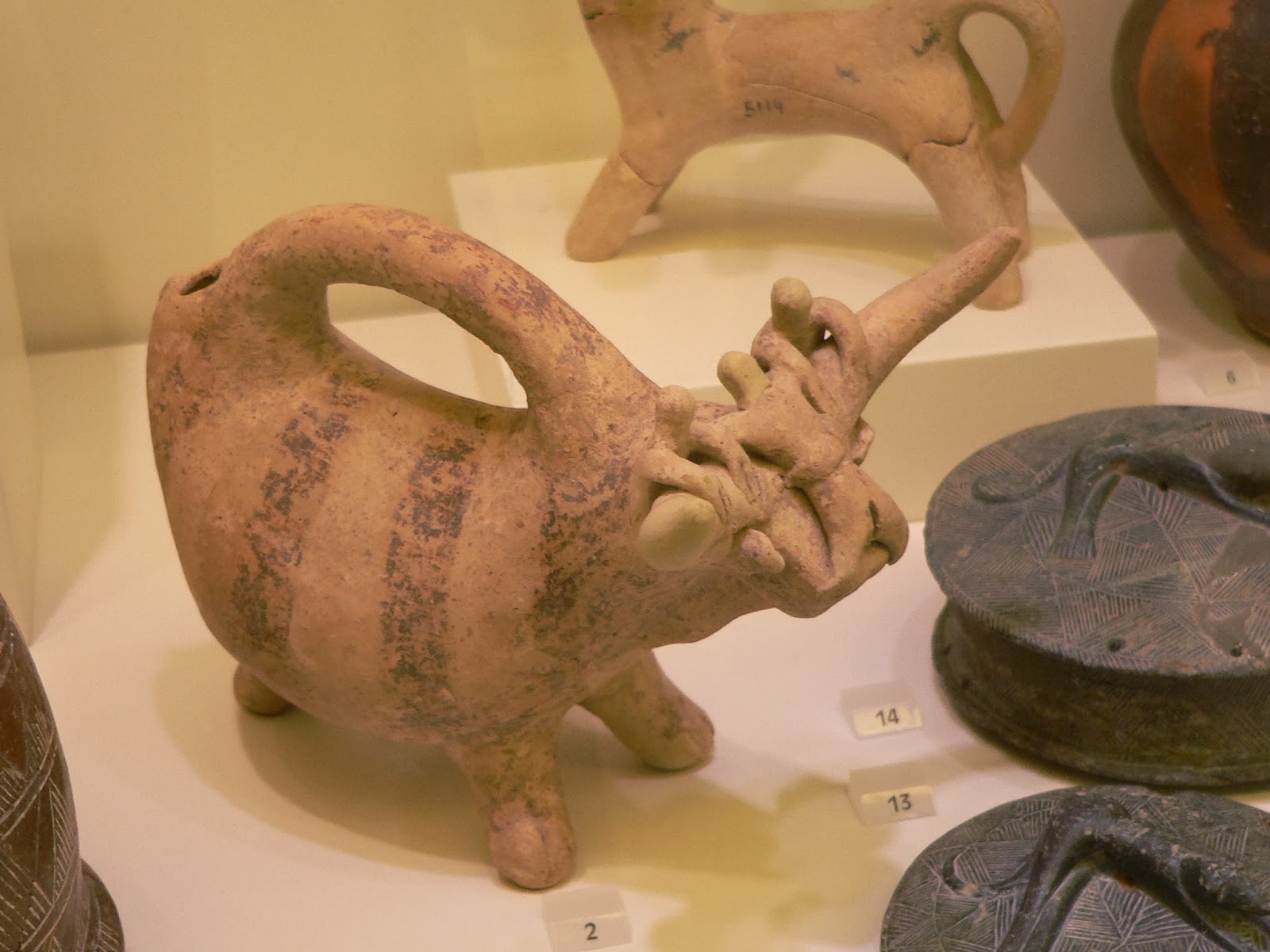
[Ponder this: the mammal could be either a bull or cow and the kids could be male or female, or some combination.]
|
| |

|
I digress.
From all that I read and all that I heard and felt while in Crete, the Minoans had a matrifocal/ matrilineal/matrilocal society. Mothers and mother values [love, generosity, and care] were honored. By both men and women.
As I imagine it, this ancient society had some gender-specific roles. In all probability, its sailors were male. It is possible that those who built the temples and cleared the land were male. Artists could, I think, have been either female or male. I’m guessing that most weavers and cooks were female. But the important thing is that nobody was dominant over others. Not males over females or females over males. Think about it. Mutual dignity and respect. Where everyone’s gifts and opinions were valued.
Shazaam.
I do not want to ‘get over’ Crete. I do want to do whatever I can to foment a non-dominational society – here and now. . |
| |
A Tribute to Crete Food
According to “Google”, Cretan cheese pies are called Kalitsounia Kritis. Unlike their Greek counterparts, they are made with pastry rather than phyllo. Fortunately, everywhere I went, the words “cheese pie” were understood and generally produced what would be sufficient motivation for a return trip to the island.
Cheese pies and all the other wonderful things I ate, suffused my days on Crete with pleasure. Nothing particularly effete. Just simple, fresh, yummy concoctions that were a joy to savor.
Perhaps some of the allure was generated by the weird eating hours. While on the fall goddess tour (www.goddessariadne.org), we’d eat breakfast at 7 or 8 a.m. then wait until 1 or 2 or 3 p.m. for lunch, then 7 or 8 or 9 for dinner.
No. The allure was the food itself.
Fresh, fresh salads.
The best yogurt I have ever encountered (made with sheep’s milk, rich and creamy and needing no sweetener whatsoever).
Wood-roasted almost any kind of meat imaginable. Fresh fish near the coast (and trout in the mountains). Lamb or pork or rabbit or goat or almost anything except beef everywhere else.
The world’s finest olive oil, used liberally for almost everything.
And great olives of course.
Incredible eggplant concoctions with amazing tomatoes.
Other delicacies, more typically Greek, like dolmades.
And the wine was fine and the raki enabled me to at least attempt Greek dancing. (Zorba I am not.) |

|
| |
Minoans Got It Right It’s been almost six months since I returned from Crete. All of my posts have had something to do with that trip. That’s probably enough (although I think I’ll do a couple more). Am I obsessed? No. Just stunned to discover evidence of a civilization that lived in peace for some two thousand years, honoring women and valuing generosity and compassion, while producing great art . . . and, surely, great food. Oopah! |
| |
Like adolescents who, after they turn 30, are amazed by their parents’ wisdom, I continue to be astounded by my ancestors – our ancestors. I’ve done of lot of reading. Every year it seems archeologists, anthropologists, even paleontologists are discovering how sophisticated the ancients were – how much they knew about how the planet works, how the stars turn, and how to live with one another.
None of my reading prepared me for Crete. Part of me didn’t really believe there had ever been a civilization in which women’s values were paramount. Where generosity, nurturing and compassion were the standards by which women and men lived and breathed and had their being. I wanted to believe it but, like you, all I had to do was look at the headlines to know that humans are a nasty lot, tirelessly striving to dominate one another.
Or perhaps not.
Anthropologist Marija Gimbutas traced thousands of years when, in what she called ‘old Europe,’ people lived in peaceful, egalitarian societies.
One of the last of these societies was on Crete. People settled on the island somewhere around 7,000 BCE. These settlers were Neolithic – early farmers. For more than 1,500 years, Crete thrived without invasion, evolving from a Neolithic to a Bronze Age civilization (the Minoan) that managed to retain its belief in the unity of life and the sacredness of this planet.
Sometime around 1,450 BCE, the Minoans were wiped out as a result of a one-two punch involving a volcanic eruption, tsunami and invading Myceneans. But their heritage is still alive – in the caves, and trees, and springs, and ruins of ceremonial complexes that you can still touch today . . . and in their great art, which you cannot touch, in various archeological museums.
Like most of the world, Crete is now as patriarchal as we are. But there are still Minoan traces – Cretans are a generous, friendly people.
With Sally Henry, I toured Crete last fall. Our tour was designed to experience the past in the present. From our first gathering circle, we formed a community. Every morning, we repeated a blessing which ended with “As this day dawns in beauty, we pledge ourselves to repair the web.” In the evenings, when we shared our stories, we repeated the mantra: I am here, I am whole, I am [our names].
Ritual is powerful. Things repeated on a regular basis can work their way into our psyches. Circles are powerful. Often, when we gather looking into each others’ faces, we glimpse each others’ hearts. On the tour, whoever needed help got it. Whoever needed time alone, or comfort, or cash until we reached the next ATM, got it.
At every site once sacred to the Minoans, we paused before entering to be led in rituals acknowledging their significance. We took turns reading scripted rituals and, at most sites, poured libations over our individual goddess images. Often, we would sing songs or chants that seemed to echo across millennia.
Eventually, I began to believe that there really was a civilization that held the values of motherhood – nurturing and generosity – as paramount virtues. A society in which dignity was part of being human. It was more than the fact that the stone outlines of Minoan dwellings were all about the same size; it was the sense of community that vibrated up through the ruins even after 5,000 years.
We live in a culture of dominance. It’s not working very well.
What if we lived in a culture woven out of connection and relationship, built with authenticity, trust, and acknowledged interdependence? What if decisions were made by allowing responses to emerge from genuine dialogue? What if we honored the divine – in ourselves, in each other, and in all the components of Planet Earth?
We need new ways of doing things. The culture of dominance has permeated the air we breathe for so long we think it is the only way. It is not. Other ways exist. In Minoan Crete, they existed for nearly two thousand years. They are, finally, emerging again. With them -- with empathy, generosity, compassion and respect – we may indeed be able to restore the interdependent web of all existence.
Our Minoan ancestors got it right. |
|



























